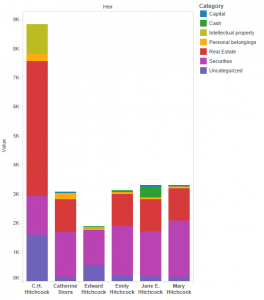Less an articulation and more a demonstration, my proposal was relatively straightforward: presenting visually what Hitchcock left behind. I took the theme of legacy, which my fellow interns and I have been and remain drawn to, literally by examining the last will and testament of Edward Hitchcock.
I compiled who got what into an Excel spreadsheet, detailing the value of inheritances and their respective categories (among other data), as seen in the snippet below.
What guided my organizational methodology were the requirements of Tableau Public—a platform «for anyone who wants to tell interactive data stories on the web.» After playing around with the service for the entirety of one morning, following how-to videos and tinkering with example data sets, I was ready to begin transforming my own collected data into intriguing visualizations like a bar chart.

It is improbable to me that much if any more than a couple of graphs could be made with data extracted from but that one account book containing instructions for the dispersion of Hitchcock’s estate. My aim was never to craft manifold presentation-ready visual aids, however. Again, my proposal was a taster of what is possible given the right data. What prompted me to pursue such a route of action was my desire to investigate the narrative oft-repeated in secondary sources—that of Hitchcock’s saving the College from financial ruin. Unsatisfied with Hitchcock’s rationalization that «the glory of this change [in the College’s financial outlook] be now and ever ascribed to a special divine Providence», I knew that I wanted to look further into the matter for causes of a less divine and more concrete nature. Indeed, I wanted specifics; I wanted to know how the College’s money was spent before and during Hitchcock’s presidency. My proposal then was to be a trial of sorts, exposing me to the sort of work (transcribing and translating primary source documents like ledgers, and perhaps even encoding them) such an endeavor would entail.
But my ambition overshot the query—already have others detailed how the College’s money was expended under Hitchcock. Almost immediately upon Hitchcock’s ascension to the presidency, the College received a few sizable donations and many more smaller ones that together constituted about a hundred thousand dollars, which equates to about two and a half million dollars today. From this sum, Amherst was able to not only pay off its debt but establish several professorships and construct buildings including the Appleton and Woods Cabinets. What each debit amounted to is documented by the likes of Stanley King, thus answering in broad strokes the question of how largesse was spent during the reign of Hitchcock and leaving me temporarily empty-handed in terms of what I could contribute to the group’s final project. Nevertheless, I came away from my proposal qua practice with a better understanding of Tableau’s functionality, and do foresee continued use of the platform, albeit for a slightly different end (the details of which will proceed with time).

